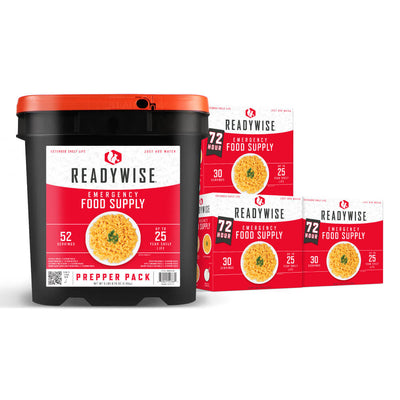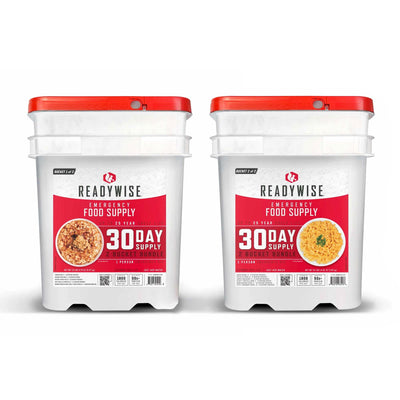Powdered milk has long been a trusted pantry staple for households, bakers, and emergency preppers alike. Its long shelf life, ease of storage, and versatility in a range of recipes make it a cost-effective alternative to fresh dairy. In this guide, we’ll explore the many benefits of powdered milk and provide practical insights on how to use powdered milk in everyday recipes—from creating a creamy drink to serving as a key ingredient in baking. Whether you're preparing your emergency food supply kit or simply seeking a regular milk alternative, this guide is packed with helpful kitchen tips and step-by-step instructions.
Note: While traditional powdered milk—typically made from nonfat milk—is common, there are different types available. For example, Ready Wise offers a unique powdered whey milk alternative. Whey milk powder generally features lower fat levels than whole milk powder because much of the fat is removed during processing. However, it's important to note that whey milk powder is still a dairy product and may not be suitable for those with dairy allergies. For more details, visit the Ready Wise Powdered Whey Milk Alternative.
Preparing Powdered Milk for Use
Before diving into recipes, it’s important to understand the best way to add water for reconstitution. This process transforms dry milk powder into a smooth, liquid dairy substitute that works perfectly in recipes and drinks. Whether you’re mixing 1 cup or 1/2 cup portions, following proper reconstitution techniques ensures a fresh taste and creamy consistency.
Reconstitution Ratios and Techniques
A common guideline for reconstituting dry milk powder is to mix about 1/3 cup of powder with 1 cup of water. Adjust these ratios to suit your desired thickness and flavor enhancement. For instance, if you prefer a lighter liquid, you might start with a smaller amount of powder or gradually add water until you achieve the perfect consistency. Here are some key steps:
- Sift the Powder: Begin by sifting the milk powder into a bowl to break up any clumps, ensuring it dissolves evenly.
- Combine Ingredients Gradually: Add a few tablespoons of cool water to the sifted powder and stir or whisk until a smooth paste forms. Then, gradually stir in the remaining water.
- Stir and Let It Dissolve: Vigorous stirring helps the powder completely dissolve. Allow the mixture to rest for 5–10 minutes for full reconstitution, ensuring a smooth, lump-free liquid ideal for recipes or as an instant drink.
While the general guidelines above work well for most powdered milk products, Ready Wise’s powdered our milk alternative is designed for simplicity and enhanced nutrition. For one serving of their whey-based product, simply combine 2 tablespoons of powder with 1/4 cup room temperature water and stir until fully reconstituted.
Tips for Achieving Optimal Flavor and Texture
To ensure your reconstituted milk has a fresh taste and creamy texture for your emergency survival kits, consider these best practices:
- Use Warm Water: Warm (but not boiling) water dissolves the milk powder more efficiently, releasing its natural sweetness.
- Mix Thoroughly: Whether stirring by hand or with an electric frother, thorough mixing is key. This is the best way to use powdered milk for creating smooth, flavorful drinks.
- Flavor Enhancements: Enhance the taste by adding a pinch of salt, a few drops of vanilla, or even a touch of sugar. These simple additions can elevate your reconstituted milk, making it a perfect substitute for fresh milk in recipes.
Culinary Applications of Powdered Milk
Once you’ve mastered the reconstitution process and understand the different types of milk powder available, the versatility in the kitchen is limitless. Its ability to add creaminess and boost protein content makes it a valuable ingredient in a variety of recipes.1
Powdered milk comes in several forms, including low-heat nonfat, high-heat nonfat, whole milk, and whey milk powders. Low-heat nonfat milk powder offers a fresher flavor ideal for beverages, while high-heat nonfat milk powder provides a sweeter, caramelized taste that enhances baked goods. Whole milk powder delivers a rich, creamy flavor but can be difficult to find, and whey milk powder offers a lean alternative with higher protein and lower fat.
Each type serves a different purpose in the kitchen, and your choice may depend on the desired flavor, texture, and application in your recipes.2
Baking Enhancements
Baking with powdered milk can significantly improve the flavor and texture of your baked goods.3 Whether you’re using low-heat or high-heat nonfat milk powder, reconstituted milk is an excellent addition to bread recipes, cookies, and cakes. High-heat milk powder, with its caramelized sweetness, can enhance enriched doughs like brioche—helping the dough rise and yielding a tender crumb that lasts longer.
Creamy Beverages
Powdered milk is incredibly easy to use when preparing drinks. Reconstituted milk makes an ideal base for a frothy latte, comforting hot chocolate, or a refreshing milkshake. Simply blend it into your coffee or mix it with your favorite fruits for a delicious smoothie. With Ready Wise’s powdered whey milk alternative, you also gain a protein-rich, creamy beverage option that stands out nutritionally.
Savory Dishes
Reconstituted milk also shines in savory cooking. A splash of milk in soups, sauces, and casseroles can act as a natural cream substitute, adding a velvety consistency without overwhelming the dish. Its neutral flavor allows it to integrate seamlessly into various recipes, making it a versatile ingredient for everyday meals.
Homemade Dairy Products
For the creative cook, powdered milk opens the door to making homemade dairy products. Learn how to use powdered milk to produce yogurt, cheese, or even ice cream. These DIY projects let you control the fat content, protein content, and overall nutritional profile of your dairy creations, all while enjoying the convenience of a long-lasting, easy-to-use product.
Storage and Shelf Life
One of the standout benefits of powdered milk is its extended shelf life, making it an excellent choice for food storage and emergency preparedness.
Proper Storage Practices
To maintain the quality of your powdered milk:
- Airtight Storage Container: Store your dry milk powder in an airtight container to prevent moisture from causing clumping.
- Cool, Dry Environment: Keep the container in a pantry or cupboard away from direct sunlight and humidity to ensure a consistent, dry state.
- Refrigerator Storage for Reconstituted Milk: Once reconstituted, treat your milk like fresh dairy by storing it in the refrigerator for 5–7 days.
Understanding Shelf Life
Unopened powdered milk can last for several years—some varieties maintain quality for up to a decade. Once opened, however, it’s best to use the product within a few months to ensure optimal freshness and flavor.4 Regularly inspect your milk for any signs of spoilage, such as off odors or unusual clumping, before using it.
Conclusion
Learning how to use freeze-dried food like powdered milk can transform your approach to both everyday cooking and emergency preparedness. By mastering the art of reconstitution—combining dry milk powder with water, stirring until it dissolves completely, and adjusting measurements to meet your recipe’s needs—you unlock a versatile ingredient that consistently delivers a fresh taste and creamy texture. Enjoy its benefits in baked goods like cookies and bread recipes, creamy beverages, savory dishes, and even homemade dairy products.
Remember, while traditional powdered milk is a fantastic staple, Ready Wise’s powdered whey milk alternative offers a unique twist with enhanced nutritional benefits. With its higher protein content and lower fat levels (compared to whole milk powder), it serves as an ideal substitute for fresh milk, especially for emergency supplies. Embrace these helpful cooking tips, experiment with different recipes, and elevate your culinary creations while ensuring your food storage remains stocked with quality, versatile products.
Sources:
- All Recipes. 16 Recipes With Powdered Milk. https://www.allrecipes.com/gallery/powdered-milk-uses/
- Martha Stewart. What is Powdered Milk - and How to Use It in Your Cooking. https://www.marthastewart.com/what-is-powdered-milk-7724741
- Epicurious. Milk Powder is the Key to Better Cookies, Brownies, and Cakes. https://www.epicurious.com/ingredients/milk-powder-baking-cookies-cake-brownie-article
- The Spruce Eats. How Long Does Powdered Milk Really Last? https://www.thespruceeats.com/does-powdered-milk-go-bad-1388298
















































































